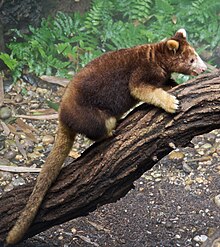Tree kangaroo
| Tree-kangaroo | |
|---|---|
 |
|
| Matschie's tree-kangaroo (Dendrolagus matschiei) | |
| Scientific classification | |
| Kingdom: | Animalia |
| Phylum: | Chordata |
| Class: | Mammalia |
| Infraclass: | Marsupialia |
| Order: | Diprotodontia |
| Family: | Macropodidae |
| Subfamily: | Macropodinae |
| Genus: |
Dendrolagus Müller, 1840 |
| Type species | |
|
Dendrolagus ursinus Müller, 1840 |
|
| Species | |
|
about 12; see text. |
|
about 12; see text.
Tree-kangaroos are marsupials of the genus Dendrolagus, adapted for arboreal locomotion. They inhabit the tropical rainforests of New Guinea, far northeastern Queensland, and some of the islands in the region. Most tree-kangaroos are considered threatened due to hunting and habitat destruction. They are the only true arboreal macropods.
The evolutionary history of tree-kangaroos begins with a rainforest floor-dwelling pademelon-like ancestor. This ancestor evolved from an arboreal possum-like ancestor as is suspected of all macropodid marsupials in Australia and New Guinea. During the late Eocene, the Australian/New Guinean continent began a period of drying that caused a retreat in the area of rainforest, which forced the ancestral pademelons to begin living in a dryer, rockier environment. After some generations of adaptation to the new environment, the pademelons evolved into rock-wallabies (Petrogale spp.), which developed a generalist feeding strategy due to their dependence on a diverse assortment of vegetation refuges. This generalist strategy allowed the rock-wallabies to easily adapt to malesian rainforest types that were introduced to Australia from Asia during the mid-Miocene. The rock-wallabies that migrated into these introduced forests adapted to spend more time climbing trees. One species in particular, the proserpine rock-wallaby (Petrogale persephone), displays equal preference for climbing trees as for living in rocky outcrops. During the late-Miocene the semi-arboreal rock-wallabies evolved into the now extinct tree-kangaroo genus Bohra. Global cooling during the Pleistocene caused continent-wide drying and rainforest retractions in Australia and New Guinea. The rainforest contractions isolated populations of Bohra which resulted in the evolution of today's tree-kangaroos (Dendrolagus spp.), as they adapted to lifestyles in geographically small and diverse rainforest fragments, and became further specialized for a canopy-dwelling lifestyle.
...
Wikipedia
